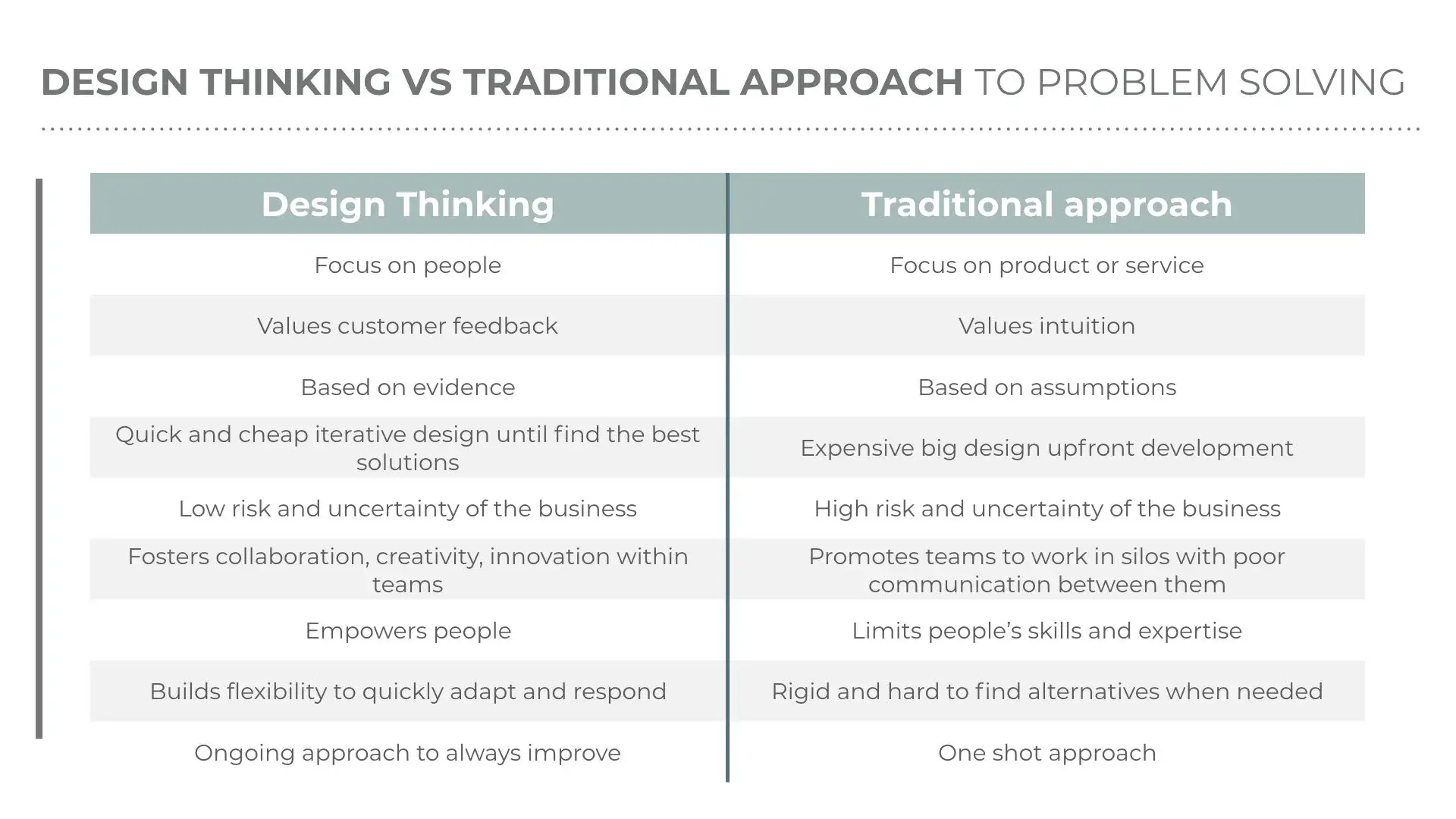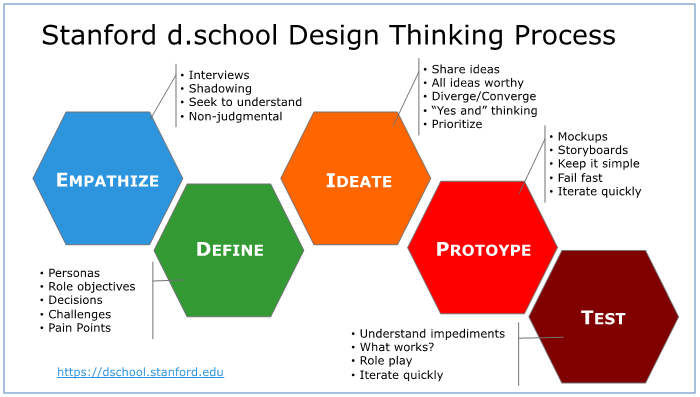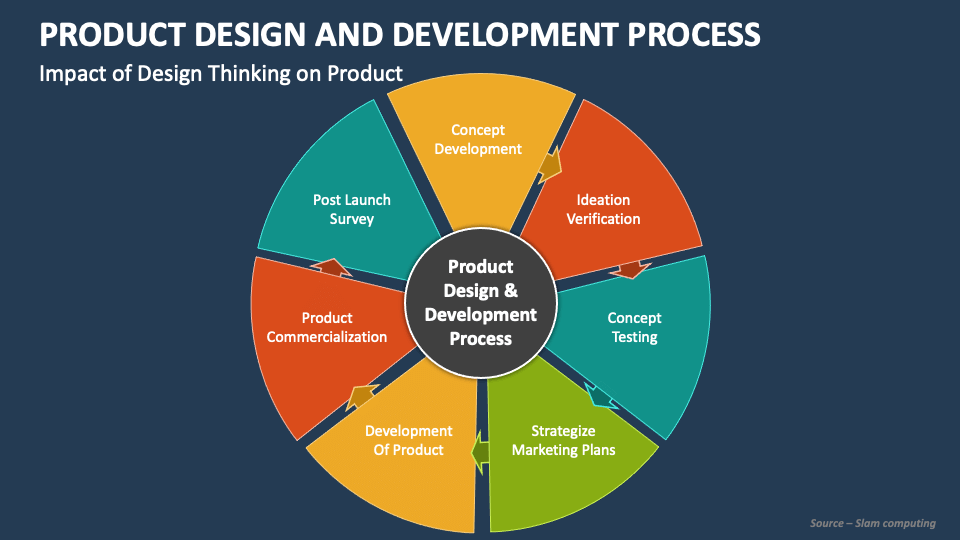What is Design Thinking? It is not easy to talk about this topic but Design Thinking always plays an important role in Product Development.
Problem-solving is an essential component of product development. However, some product development issues are more complex than others, and it can be difficult to find the right solution—or even know where to begin looking.
This is where design thinking comes into play, putting users at the center of every process by combining problem-solving with deep empathy.
This guide provides an in-depth look at design thinking as a problem-solving strategy. In this first chapter, you’ll learn what design thinking is, why it’s important, and how it can help you create products that you’re proud to bring into the world—and that your users will love.
What is design thinking?
Design thinking is a problem-solving approach to product development that focuses on the user to assist teams in identifying issues, reframing them, and developing creative solutions.
It is a user-centric solution-based ideology, process, and collection of hands-on methods for solving complex problems. Design thinking is most useful for addressing ill-defined or unknown problems by assisting you to:
- With a user-centric mindset, redefine the problem.
- Determine the issue that must be resolved.
- At brainstorming sessions, brainstorm ideas that can be implemented.
- Prototyping and testing should be done by hand.

Who is design thinking for?
Design thinking, despite its name, is not only used by designers. It is, instead, a human-centered approach to innovation that is used in science, art, engineering, and business.
Design thinking has been extremely successful in showcasing relevant solutions to real-world problems in the world of product development. It enables teams to conduct better UX research, prototyping, and usability testing in order to discover new ways to meet the needs of users.
Design thinking assists you in focusing on practical outcomes and solutions that:
- Meet and address a genuine human need
- Can be transformed into useful products or processes
- Are they economically viable?
It also aims to turn ideas into tangible, testable products as quickly as possible, and to make changes and improvements before constructing the final product.
5 Design Thinking Facts You Should Know
Design thinking has long been regarded as the pinnacle of innovation. However, before incorporating it into your own workflows, you must first understand what it is and why it is so popular.
Design thinking arose as a method of teaching engineers how to approach problems creatively, as designers do.
John E. Arnold, a mechanical engineering professor at Stanford University, invented the concept of design thinking. From there, it evolved as a method of creative problem-solving and thinking, resulting in IDEO’s iconic 1990s run and Stanford University’s d.school design thinking course as a method of technical and social innovation.

Today, design thinking allows us to reimagine the world and the products, systems, or institutions that reinforce how people interact with one another. From Apple to Google, and from Samsung to IBM and GE, some of the world’s leading brands are using design thinking to drive innovation and results.
Design thinking entails approaching a problem from the standpoint of the user with a designer’s mindset.
You have this amazing power of wide-eyed curiosity as a designer. In terms of product, user experience, strategy, or complex systems, what does the world—or even just one person—need? Can design aid in this endeavor?
With an inquisitive approach that embraces empathy, optimism, iteration, creativity, and ambiguity, a designer is uniquely equipped to deal with these complex problems.
Design thinking, as a solution-based approach to innovation, employs techniques from the designer’s toolkit to solve problems in a creative and innovative manner. The designer’s mindset assists you in observing and developing empathy with the user—it inquires about what they want and need from your product and how you can use design to make that a reality.
Design thinking is founded on five fundamental principles.
The design thinking methodology incorporates the five design thinking principles, which are summarized below:
- User-centricity and empathy: human-centered design thinking places people at the center of every process. A good designer understands that staying focused on the people you’re designing for—and listening to them directly—allows you to arrive at optimal solutions that meet their needs.
- Collaboration: design thinking techniques and strategies are appropriate at all levels of business. Diverse perspectives and ideas inspire innovation, which should include colleagues from various departments to form a cross-functional team.
- Ideation: Because design thinking is a solution-based framework, the emphasis is on developing as many ideas and potential solutions as possible. These are not necessarily novel (or good) ideas, but they can serve as the basis for new solutions to be tested with prototypes.
- Experimentation and iteration: the design thinking process includes early and frequent testing of your solutions; this allows you to gather feedback and make any necessary changes long before the product is fully developed.
- A proclivity for action: design thinking is a very hands-on approach to problem solving. This entails transforming ideas into tangible prototypes and testing them in real-world contexts—a critical step in evaluating new ideas and identifying the changes required to make them work.
Design thinking is a framework for solving problems, not a problem-focused approach.
The way you approach a problem can influence how you solve it. Design thinking provides an alternative to problem-focused approaches by emphasizing what is working (or could work) rather than deficits, limitations, and weaknesses.
A problem-focused approach aids in the identification of the problem, why it exists, and when and where it becomes a source of pain for your users. The approach allows you to analyze a situation and determine where the breakdown is occurring—but you still need to determine what happens next.
A solution-focused approach, on the other hand, assists you in resolving the issue. This approach allows you to identify strategies to resolve the issues that are causing the problem in the first place, in addition to identifying the problem and when and where it occurs.

Solution-based approaches to product development produce more positive outcomes and better products. Because customer goals and success metrics are at the center of a user-first approach like design thinking, it simplifies everything across product teams, marketing, sales, and client services.
A solutions-driven organization approaches everything from the perspective of the users first, allowing you to:
- Empathize with the habits, behaviors, and needs of your users: discover new opportunities to improve the user experience by empathizing with users and seeing their experience objectively
- Create a frictionless user experience by identifying user pain points and designing a solution that balances user and business needs.
The emphasis is on developing as many ideas and potential solutions as possible, thinking “outside the box,” seeking alternative perspectives on the problem, and identifying innovative solutions to the design thinking problem statements you’ve created.
Design thinking is a non-linear, iterative process that encourages constant experimentation.
The design thinking process encourages creativity, innovation, and user-centricity while also assisting you in developing actionable solutions. As previously stated, the process outlines a set of principles, or stages, that help to bring this ideology to life:
- Empathize: learn about your users and their problems.
- Define: determining what problem must be solved
- Ideate: think creatively about solutions and angles.
- Prototype: Create a tangible version that users can then test.
- Test: exposing your prototype to real users to determine whether or not your solution is viable.
These five stages can be completed in parallel, repeated, and circled back to at any point during the process.
Even after you’ve defined your problem statement, you should continue to build empathy with users by using design thinking tools such as surveys and feedback software to validate your problem statement and update your assumptions.
The process’s goal is to enable you to work dynamically to develop and launch innovative ideas. The goal of the design thinking process remains the same regardless of how it is implemented: to approach complex problems from a human perspective.
How design thinking assists teams in creating better products

Design thinking is a tool for problem-solving, creativity, and innovation:
- It assists designers in developing an understanding of user habits, behaviors, frustrations, needs, and desires.
- It enables managers to foster a user-centric culture at all levels of the organization.
- Most importantly, it enables teams to create game-changing products that users actually want.
Design thinking enables teams to express and share their ideas. It allows you to be ambiguous and messy while knowing you’re moving in the direction of your desired outcomes. It’s a way to get started and be willing to have 100 sketches on the floor that don’t work before you find the one that does—from ambiguity to clarity, refinement, and launch.
Design thinking can have an impact and provide innovative solutions to issues that product teams are passionate about:
Tackling complex challenges
Design thinking promotes innovative problem-solving. It pushes you deeper into the questioning process, challenging the problem, assumptions, and implications.
A good design thinking framework will provide you with new insights into your users’ lives, including the challenges they face with your product and the moments that delight them.
Empathy can provide you with the insights you need to solve difficult, worthwhile problems.
This is especially useful in the context of product development, whether it’s designing a competitive product, optimizing internal processes, or completely reinventing a business model.
Moving at a faster iterative rate
Design thinking prevents you from making assumptions or designing patterns out of habit. Instead, it shifts the focus from your problem to the best solution for your users.
Designing a product based on user observations is far more productive than starting from scratch. This shortens the development process by assisting you in designing better products that your users want from the start.
Design thinking also aids in the scaling of the design process across large organizations. It keeps the team and stakeholders on the same page and increases efficiency by using an agile design thinking approach to early-stage feedback, which prevents you from wasting resources on unpromising ideas.
To ensure customer delight, meet and exceed customer expectations.
Design is all about empathy. It connects you, the designer, to the people who will benefit from your work, allowing you to create products that, in the end, meet genuine human needs.
Design thinking revolves around a deep desire to understand the people for whom you are building, thereby creating the conditions for continuous innovation.
Design thinking allows teams to generate real-world solutions. It is not enough to come up with ideas; it is also necessary to turn them into prototypes, test them, and make changes based on user feedback.
Reducing uncertainty and increasing trust in design decisions
Obstacles can arise during the product development process. Your team either collects a lot of backward-looking data that doesn’t tell you what current or future users truly want, or you make risky bets based on intuition rather than evidence.
Design thinking is a strategy-creation tool that focuses on human behavior. You can discover new strategies and enter new markets by employing imaginative, human-centered problem-solving. Design thinking also helps product teams reduce assumptions, which allows you to better understand users and deliver products that delight them.
Developing this level of empathy for your target users means you’ll be able to create products they’ll want to use and return to.
Contact US | ThimPress:
Website: https://thimpress.com/
Fanpage: https://www.facebook.com/ThimPress
YouTube: https://www.youtube.com/c/ThimPressDesign
Twitter (X): https://twitter.com/thimpress


